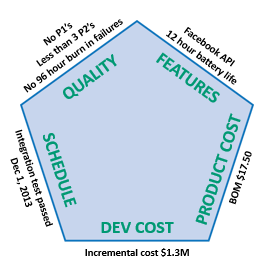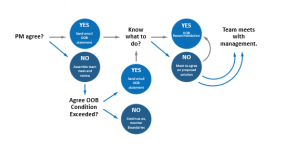Lean Product Development Processes For Innovation And Speed
 Through our hands-on work with clients, we have developed a lean product development process. It is a methodology that depicts key milestones, but supersedes specific engineering models such as waterfall or Agile. However, we have incorporated selected practices from the agile toolkit to enhance innovation and speed products to market.Â
Through our hands-on work with clients, we have developed a lean product development process. It is a methodology that depicts key milestones, but supersedes specific engineering models such as waterfall or Agile. However, we have incorporated selected practices from the agile toolkit to enhance innovation and speed products to market.Â
The beauty of this process is that there are typically only three checkpoints in your overall product life cycle and these support Agile/Scrum methodology. These checkpoints are defined interactions between the management team and the core cross-functional development team. Not reviews or gates, these check-ins are inflection points in the lifecycle of a project. They get the team and management on the same page and also ensure that the organization will see a payback from its investment. They are more like peer-to-peer discussions than a critical, hierarchical, and stress-filled review.
Our lean product development process establishes a ‘contract’ between the core team and the management team. The two parties negotiate specific parameters for the proposed project, for example around features, price and quality. We call these parameters boundary conditions. So long as the team doesn’t violate these pre-defined boundary conditions, and it looks as though they’re delivering on their contract, management leaves the team alone. If the boundary conditions are violated, i.e. if it appears that the team will not deliver the project according to the agreed upon parameters, then the team follows an accelerated resolution process. 
This resolution process, which renews or amends the contract between the team and management, should take place in hours or days as opposed to weeks or months. This escalation process empowers the team to propose solutions that will get the project back on track. If the proposed solution is sufficient, Management, in a messaging channel or email, can permit the team to take the action it proposes.
In the lean product development process diagram below, time flows from left to right. The triangles indicate the key, loose interaction points between the team and management. The position of each triangle illustrates approximately when check-ins take place. Specify the boundary conditions for the project at the Concept Check-in and refine them at the Product Check-in.
If the project stays within its boundary conditions, you do not need any more check-ins until the product is near release. The Release Check-in, right before the launch of the product, ensures that the new offering will meet or exceed expectations because at this point management will have all the test data necessary to make the launch decision.
The Art of the Check-inÂ
We call these key points in the projects ‘Check-ins’ because there’s a presumption that the team will not prepare a great deal of material beforehand. If the project has delivered on its boundary conditions then there’s an expectation of management approval. There are three defined check-ins in our lean product development process. There’s also an opportunity to check-in at any time, if the team believes that there is potential for the project to violate its boundary conditions.Â
The first check-in is the Concept Check-in, where the management team aligns the project with the current strategic priorities and outlines its major objectives. This check-in ensures that the investment in the project is consistent with the product strategy and product portfolio.
At the Product Check-in you finalize the definition, rough out a schedule, and complete a high-level design that demonstrates feasibility. You can often perform this check-in just before the team commits large expenses to the project. In keeping with the use of Agile and Scrum, this can be thought of as a ‘Demo’ at the end of a key sprint as provided for in the Release Plan.
The third and final check-in is the Product Release Check-in, which is the point of no return where your organization assesses its capability to launch the product. The areas of focus in this check-in (or Demo) include customer support capability, product quality, and product performance.
The Out-of-Bounds review occurs when the team believes they will not meet the boundary conditions set out at the beginning of the project. This review follows a clear communication path and escalation plan to quickly establish new boundary conditions, and get the team headed once more toward its goal, with only minimal interference from management. This review is a blame-free way to respond creatively to a break in the boundary conditions. The focus is on making the best decision for your company — which may include cancelling the project.Â
With this agile development process, your team has enormous latitude for innovation during the entire product life cycle, absent meddling from management and time-consuming reviews. By helping management and the team agree on the areas of major emphasis and empowering the core team to manage them, you have created a situation for success and creativity, rather than a stressful environment burdened by micromanagement.Â
Lean Product Development Process Enabled by Trust
With this approach, Management places trust in its development teams. The greater trust allows the team to have ownership and engagement. It fits with the new style of delegation where teams are truly empowered.Â
Also, many organizations are struggling with so much process that they are choking on bureaucracy. We are finding that many organizations, especially the more mature ones, are cutting back on process complexity. They are following a path towards a leaner process, while they still hold firm to some of the tenets of rapid development, including a small number of team-on-team interactions, the core-team concept, and team meetings to assess the cross-functional risks.
The benefits of the lean approach to product development include:
- Innovation encouraged by empowering the team.
- A team focused on the core value propositions.
- Rapid communication of a possible problem or project failure.
- Increased motivation due to the trust placed in the team.
- Improved time to market since the team is not waiting for management to be in one room at the same time.
Image credit: Pixabay
Wait! Before you go…
Choose how you want the latest innovation content delivered to you:
- Daily — RSS Feed — Email — Twitter — Facebook — Linkedin Today
- Weekly — Email Newsletter — Free Magazine — Linkedin Group
 John Carter has been a widely respected adviser to technology firms over his career. John is the author of Innovate Products Faster: Graphical Tools for Accelerating Product Development. As Founder and Principal of TCGen Inc., he has advised some of the most revered technology firms in the world.
John Carter has been a widely respected adviser to technology firms over his career. John is the author of Innovate Products Faster: Graphical Tools for Accelerating Product Development. As Founder and Principal of TCGen Inc., he has advised some of the most revered technology firms in the world.
NEVER MISS ANOTHER NEWSLETTER!
LATEST BLOGS
The Incredible Shrinking Laptop
As technology advances and people’s demands for ever-thinner, ever-lighter laptops increase, more and more the thickness of a laptop is…
Read MoreA Revolution in Management Consulting?
Management consulting firms are built on a model that requires the maintenance of a bench of their people to staff…
Read More





